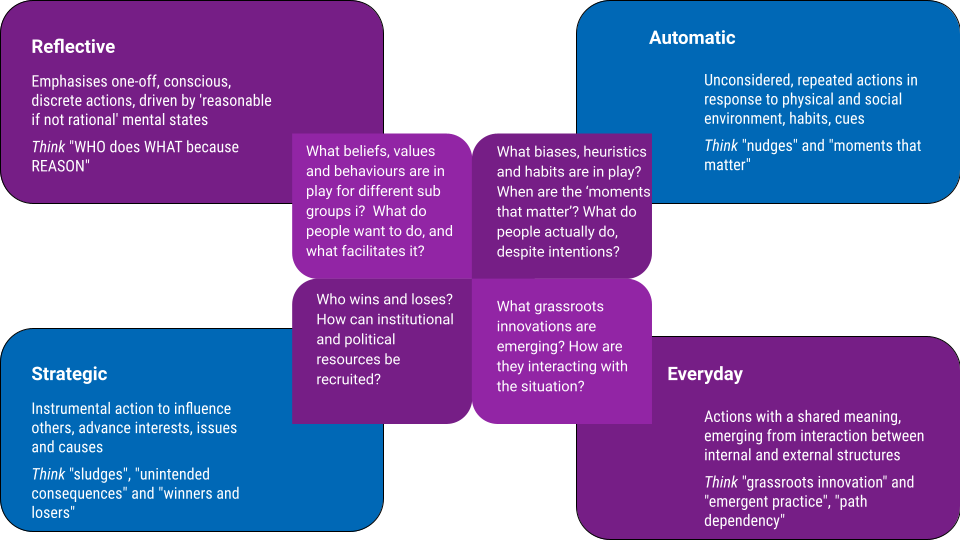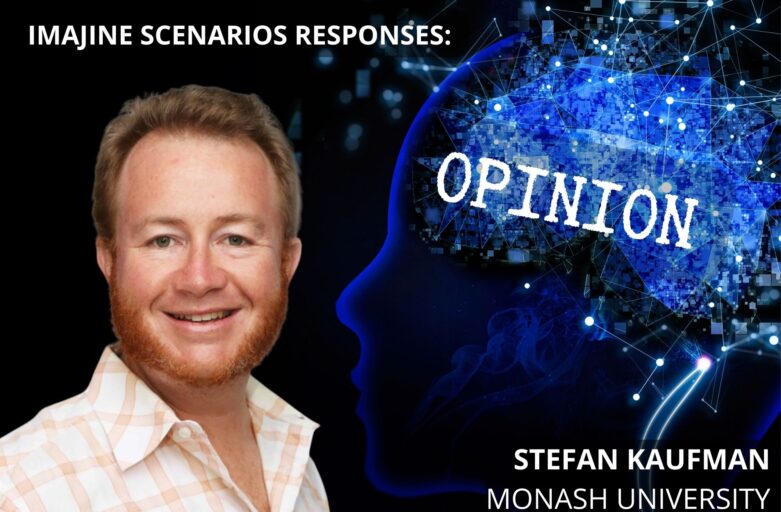In this blog post, Stefan Kaufman of Monash University’s BehaviourWorks explores the IMAJINE scenarios from the perspective of behavioural science, insights, and interventions.
I’m coming at this as a former environmental regulator with experience in regulatory foresight and intelligence, a science fiction geek and a present day researcher who started in human ecology and ended up in behavioural science: exploring how a focus on behaviour can help us understand and accelerate the multiple and urgent sustainability transitions required for humanity to flourish into the future.
Specifically, I apply 4 lens’ of behaviour in sustainability transitions to each scenario, the results of a review exploring how sustainability transitions research and practice engages with behaviour change. These provide a set of frames for understanding and inquiring into each scenario.

Silver Citadel
The doubtful feasibility of continued ‘strong growth’ led me to wonder if the citadel’s relatively ‘good’ internal conditions are maintained at the cost of a climate struck, dystopian global context – think of Ian Mcleod’s “The great wheel”. If the silver citadel protects its citizens in a high tech, bio-and-geo-engineered oasis surrounded by fields of bloody skulls, should it exist, and does it really have a future in the long term?
Strong solidarity suggests that there is a level of acceptance of ‘big government’ and strong policy interventions with traditional policy tools. This aligns with the ‘strategic’ lens. Technocratic policy might be informed by reflective and automatic behavioural science here, but mainly to support policy acceptance, anticipate unintended consequences, and smooth policy implementation. While the scenario appears positive (for EU residents), risks to attend to might include exploring to what extent vested interests, blurring the lines between state and business, are embedded in the system that might be rent seeking or be so wedded to maintaining the status quo, that the EU lacks the ability to adapt to inevitable external shocks and surprises, especially ‘excessions’/black swans’. This is particularly likely in the ‘great wheel’ story for example.
From the automatic perspective, the combination of A.I. and big government is thought provoking – one could imagine that ‘general intelligence’ AI would be better at exploiting ‘nudge’ techniques than humans. If that AI is aligned with human goals in a heterogenous, tailored and flexible manner, citizens might have ‘boosts’ to live out their preferences via ‘micro-targeted’ policies and interventions to a degree comparable with individual medicine or gene therapy (e.g. achieving that savings plan, reducing energy consumption, eating healthily, reducing racist micro-aggressions, etc.). Maybe this is what happened to wine drinking in this scenario!
However, if a given A.I is a ‘smart idiot’, we might find behavioural policy interventions unintentionally supercharging inequalities and conflicts by failing to be sensitive to fine grained differences in preferences, options and contexts. And if AI emerges from this scenario that is just not interested in helping humans achieve their goals, we might find that the combination of their role in the system and behavioural insights hands them the ‘human manual’ by which we can be ushered with kid gloves to a pretty dark place.
The everyday perspective further prompts us to ask what emergent co-equilibriums of behaviours in context might be lost in a strongly centralised model. Europe’s rich heritage of ‘vernacular’ solutions to the constraints and opportunities of local resources, climate, practices and culture and economies might be increasingly alienated in this scenario, amid increasing reliance on the globalised macro-system and ‘iron cage’ of a technobureacratic world.
One wonders if a mass produced, standardised context can feed the soul while prioritising material progress – suggesting a brittleness of wellbeing in this scenario. This too would degrade the adaptability and resilience of the EU, and perhaps more importantly, risks denying its citizens the subtle emergent ‘solutions’ to different configurations of social, economic and environmental systems that make it such a rich patchwork in the present day.
The everyday perspective also reinforces the critical analysis of the ‘strategic’ perspective – reminding us to recognise the entanglement of policy makers and other powerful actors in shaping what otherwise might be shallowly accepted as ‘consumer’ or ‘citizen’ preferences that the Silver Citadel delivers.
Green Guardian
High solidarity in this scenario makes sense: external shocks and threats have been shown to increase solidarity and adherence to norms (Gelfland). Nudges, persuasive communications and social marketing leveraging this would all have played a huge role in supporting pro-social behaviours for the health of people and the planet. This is a scenario where behavioural public policy can be its most positive – supporting people to consistently act not in response to short term prompts, but instead turn to the benefit of the greater good and their future selves (i.e. ‘nutritious, instead of ‘delicious’).
The strategic perspective asks who is deploying this range of tools, and to what end? It suggests strong, but localised mission-driven and purposeful networked governance collectives and institutions such as we see emerging around regional circular economy transitions (Cramer). Perhaps the Dutch sea-level rise exodus saw this spread from Amsterdam to the rest of the EU? And perhaps we would also see the proliferation of community wealth building and cooperatives and mutuals like the Mondragon model. The everyday perspective provides a rich insight into the dynamics of how these regional co-equilibriums of meanings, capabilities and materials might emerge. It suggests an EU of flourishing grassroots innovations combined with strategic niche management via savvy policy implementation to realise this scenario.
One example of this mix of grassroots innovation and strategic niche management is suggested by my current research into climate resilience, farmers and natural capital markets. The restructuring of urban-rural relationships might have been boosted by the behaviouralisation of policy tools like payments for environmental services, environmental markets and certification schemes with reflective and automatic informed interventions to reduce barriers and boost facilitators. This ensures that land managers are rewarded and recognised for shifting from more extractive and productionist farm business models to protecting and enhancing natural capital and environmental services, reducing impacts while increasing climate resilience. Fostering and supporting enactment of’ Stewardship’ values are key to this.
While the decline of urban areas may also reflect a fracture point, the same mechanisms may help urban residents value and respect the origins of food and fibre, and build stronger relationships through the value chain, support volunteering and so on. Local institutions’ ability to provide trusted, relevant and accessible social and technical support will be important in facilitating this transition via such policy interventions, for example via cooperatives, extension networks and regional organisations. They are really key for mediating the considerable barriers land managers face for engaging with natural capital markets, representing a further ‘tailwind’ for this scenario emerging.
Silicon Scaffold
Like its name, this scenario sounds brittle and temporary to me. Multiple planetary boundaries are being approached and exceeded now in 2022, biosecurity and pandemics are a mainstream concern, and the corrosive effects of inequality are increasingly clear. It’s hard for me to imagine a world just 26 years from now where multinational corporations can continue to gain the consent of localised communities, states and the EU into accepting a continued privatisation of profits and socialisation of costs and externalities. This is especially so given the increasing pluralisation of information and expertise reducing their ability to exploit information asymmetries and ‘capture’ governance and media.
Similarly, while socio-technical ‘bubbles’ may facilitate citizens disconnecting from their local environments temporarily, I would imagine this will be a temporary buffer at least. It’s hard to maintain sustained disconnection from nature and telecommute to work and access digital social and entertainment spaces at home once the heat wave overwhelms your air conditioner, power drops out and your neighbourhood is flooded, awash with chemicals from the unregulated auto-manufactory around the corner, and socially and economically alienated people from a neighbouring disadvantaged region are rioting in streets (presumably in floaties). This would also be a poor wellbeing scenario, given our reliance on connection to nature, physical activity and deep social connection for wellbeing.
Perhaps this scenario emerges from a level of symbolic or actual co-option, where individuals are persuaded by marketing, seduced by privatised health benefits and coerced by monopolies into identifying more strongly with the corporation than their local community and government. From this point of view, if this isn’t to be a very dark world indeed, the EU would play an important role in protecting the ‘cognitive sovereignty’ of its citizens by very effectively detecting and preventing ‘sludges’ and other ‘dark patterns’ of automatic and reflective behavioural insights, which private interests are already frighteningly better at doing, than governments are at detecting and preventing.
The everyday perspective suggests that even here, we might see emergent social innovations and adaptations that could present the new sub-politics and niches of a better transitions as people bend towards more communitarian existences despite this context. Perhaps this would look something like the ‘philes’ described by Neal Stephenson in The Diamond Age – anarchic virtual and physical communities of technology skilled and powerful individuals, connected by their chosen identification with a socio-cultural identity and a ‘generosity’ economy.
Patchwork Rainbow
And perhaps ‘diamond age’, above, suggests this last scenario as an alternative, which I find more plausible than the previous, and certainly more attractive. Again, I think increased literacy and efficacy of the EU and governments in monitoring sludges and other dark exploits would play a role in whether and how this scenario roles out. The US’s experience of ‘cambridge analytica’ and the broader ‘pollution of the public square’ suggests how political and PR actors can manipulate disinformation via micro-targeting in pursuit of power.
This is strategic weaponisation of behavioural insights from both the automatic and reflective perspectives. Is a totalitarian state as likely an outcome as a rainbow patchwork? It is not inevitable that they get away with this, but the co-option of democratic institutions which results from such manipulation suggests that we have a rapidly closing window in which to act.
At the same time, the emergence of ‘the risk society’ and ‘reflexive modernity’ from the mid 20th century onwards suggests that, even without deliberate pouring of behavioural science fuel on the fire, these trends are present and increasing. To a degree, this is a necessary everyday correction of overly optimistic models of progress and enlightenment (modernity) that were blind to their unintended consequences and feedback loops, displaced in time and space by a globalised economy.
From this point of view, given the uncompromising reality of an interconnected world, I suspect there would be a level of ‘socio-technical darwinism’ in which plural regional configurations can sustain themselves in this scenario.
Where there are sufficiently salient and timely feedback loops across social, economic and environmental systems, we might see multiple flourishing adaptations and equilibriums emerge. However, what comes with this is the ‘failed experiments’ and their consequences. Maladaptive delusions and anti-science positions will only last as long as they are not exposed to material consequences, in the face of which they will inevitably, eventually, collapse. This suggests even radically different local regional clades and philes will have an interest in mitigating the worst impacts of strongly maladaptive configurations through some form of influence, cross-subsidisation and cooperation. It’s thus hard to see cross-regional governance completely disappearing in the rainbow patchwork either.
I appreciated the chance to stretch my mind with these scenarios. They are an important reminder of how present day trends and dynamics may play out in surprising ways, and take us to futures we may or may not want to inhabit. I’ll be fascinated to see what deliberate and intentional steering of futures this leads to, and hope this initiative serves as a partial antidote to the continued ‘muddling through’ of short termism driving so much of our steering of socio-technical systems today.
Find the full IMAJINE scenario text online.
[1] Kaufman, S., Saeri, A., Raven, R., Malekpour, S., Smith, L., 2021. Behaviour in sustainability transitions: A mixed methods literature review. Environmental Innovation and Societal Transitions 40, 586–608. https://doi.org/10.1016/j.eist.2021.10.010

